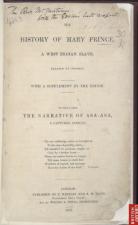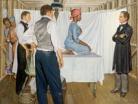Olaudah Equiano was an abolitionist writer who wrote his memoir: The Interesting Narrative of the Life of Olaudah Equiano, which showcases the wickedness he and other Africans had to endure by being stripped from their home and sold into slavery. It was published in London during the year 1789. He was stolen from his village by freelance slavers and was a slave in Africa, only to be shipped to Barbados and North America. Once enslaved he was able to purchase his freedom from an American Quacker merchant, Robert King, and he settled in London where he wrote his story (Anthology). The narrative was meant to evoke emotion from the British audience of that time, by divulging intimate moments from his life, which ended up working according to a newspaper article written in 1789: “And how can we, without blushing, congratulate ourselves on the blest privilege of liberty and independence, when, in defiance of the faith, we profess, we thus wantonly deprive a people, equally independent with ourselves, of blessings we so highly prize” (General Magazine). This demonstrates that Equiano’s narrative had an impact on society and even magazines during that time questioned the unethical practices of African Americans. Equiano’s slave narrative demonstrates his ability to turn from an object to a possessive individual. He had at first faced adversity, only to overcome it and make a name for himself, by fighting back against the harsh systems and policies that tried to separate him from society in the first place.
In the narrative, Equiano recalls horrific events that he had seen happen: “On my refusing to eat, one of them held me fast by the hand, and laid me across I think the windless, and tied my feet, while the others flogged me severely” (Equiano). He experienced multiple accounts of cruelty and confusion. The mistreatment of Africans had not only been an advantageous power move for the ones in charge, but it also highlights the oppressive society that Africans had no choice but to endure. Because of the policies in place, there was no one to stand up against the system to acknowledge what Americans were doing was unjust and unethical. In an article written by Mallipeddi: “Filiation to Affiliation: Kinship and Sentiment in Equiano’s Interesting Narrative” they state: “After returning to London as a freedman, he generates horizontal ties of affiliation with the expatriate black community to promote the causes of abolition and racial upliftment” (Mallipeddi 24). Although there were not many people to uplift black lives, it is important to recognize the effort that Equiano took upon himself after he had gained his freedom.
Similarly, these circumstances can remind one of the Relf case because the Relf girls were also taken out of their homes without consent. The lines: “I was immediately handled and tossed up to see if I were sound by some of the crew; and I was now persuaded that I had gotten into a world of bad spirits, and that they were going to kill me” (Equiano). This reminds me of the girls in the operating room confused as to what was going on. In Equiano’s narrative, he is convinced that the handlers are going to kill him, and a similar fear is running through the Relf girl’s minds. Another correlation that can be made is the idea that after a horrendous act had been done to Equiano, he spoke out against the atrocities that were happening. The Relf girls had also spoken out against the wrongs that they endured and found a way to alert what was happening in their community as well. Equiano’s narrative is a reminder that the mistreatment of African Americans goes back to the beginning of history.
The last correlation that can be made is to The Abundant Birth Project. These two events coincide with one another by Equiano demonstrating the horror that black lives faced during slavery. It highlights the beginning of systemic racism by putting black lives in danger, beginning with slave owners lacking empathy for human beings, similar to problems that we still see today in medical malpractice in African Americans.
Work Cited:
MALLIPEDDI, RAMESH. “FILIATION TO AFFILIATION: KINSHIP AND SENTIMENT IN EQUIANO’S INTERESTING NARRATIVE.” ELH, vol. 81, no. 3, 2014, pp. 923–54. JSTOR, www.jstor.org/stable/24475611. Accessed 25 Apr. 2024.
"The Life of Olandah Equiano, Or Gustavus Vassa." The General Magazine and Impartial Review, 1789, pp. 315. ProQuest, ulib.iupui.edu/cgi-bin/proxy.p…...
Associated Places
Riding House Streetby Maria Croddy




